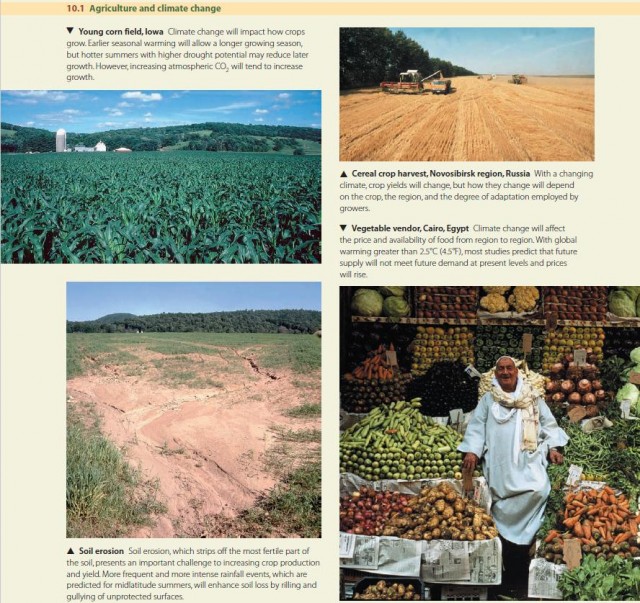Global Change and Agriculture
For the remainder of the twenty-first century, and probably well beyond, our global climate will change. The Earth will become warmer, especially in mid- and high latitudes. Most areas will have more precipitation, although higher temperatures will often bring more summer drought stress. Extreme events—heavy rainfalls and high winds—will be more frequent. How will global climate change impact agriculture? (Figure 10.1)
In general, higher temperatures will increase the productivity of most mid- and high-latitude crops by lengthening their growing season. But once temperatures get too high, the effects will be negative as heat stress reduces growth. Global warming is also expected to reduce minimum temperatures. This will be beneficial for many mid- and highlatitude crops but detrimental to some tropical and equatorial crops.
On the other hand, a significant CO2 fertilization effect will occur as atmospheric CO2 concentrations double. Because CO2 is present in the atmosphere only in low concentrations, CO2 limits photosynthesis in many situations. With higher CO2 concentrations, plants become more productive. This fertilization effect is well documented in many studies, both in greenhouses and by free-air release of CO2 gas upwind from agricultural fields.

What are the combined effects of rising temperatures and increasing CO2 on crop yields? In general, recent studies show that if warming is less than about 2.5°C (4.5°F), yields increase, but if greater, yields decrease. However, the predicted changes for different crops and regions vary significantly.
An important factor affecting yields is adaptation. Adaptation describes actions that respond to climate change, such as changing planting and harvesting dates, selecting different strains of crops, changing the crops that are planted, adding or modifying irrigation, and using more or different fertilizers and pesticides.
Studies show that adaptation can mitigate many, but not all, of the negative effects of predicted changes in temperature and rainfall. Other factors are also important. Soil degradation, which includes erosion of productive soil layers and chemical depletion of nutrients, is a major challenge. Irrigated land is increasing, but so is irrigated land that is degraded by salt accumulation and waterlogging.
Soil erosion will increase as more frequent high-rainfall events induce rilling and gullying. Wind deflation of productive soils will also increase if global warming enhances wind speeds. Insect pests will migrate with climate change, inflicting new regions but possibly leaving old ones. Weeds are stimulated by warm temperatures and higher levels of CO2, and in some cases, will compete more effectively with crops. For livestock, climate change will affect the nature and availability of forage and grain, as well as animal diseases and parasites.
What are the likely effects of global climate change on food availability and food prices? So far, agricultural production has expanded to meet the needs of the world's expanding population. Will it keep pace with demand? Most studies predict that with global warming greater than 2.5°C (4.5°F), demand will exceed supply and food prices will rise. Vulnerable populations, such as marginal farmers and poor urban dwellers, will be placed at greater risk of hunger. However, if adaptation
to climate change is effective, these risks will be reduced.
Agriculture is a human activity that is essential to us all, and the effects of global change on agriculture will be significant as our climate warms and CO2 levels rise. Let's hope that our species is smart enough to adapt to the changes and provide an abundance of food for all.